
You can tell simply by looks that a human eye and the eye of an animal are not the same, so it makes sense that we see color differently. When an animal, like a chicken or pig, sees the same light we see, they perceive something different because they have an entirely different set of photoreceptors.
As you can see in the human eye drawing below, the retina at the back of the eye. This is where photoreceptors are located. The two types of photoreceptors that are directly involved with sight are rods and cones. Rods work at low light levels (i.e. night vision), while cones are stimulated by light and used to see color.
Learn more about the human eye.
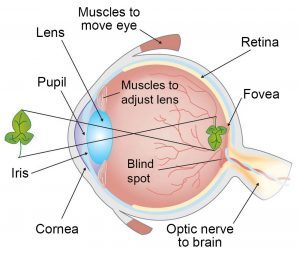
Two additional key photosensitive in birds, non-visual, organs are the pineal gland, photon absorption by functional photoreceptors located in the pineal gland on the top of the brain, and hypothalamus reception, photon absorption by deep encephalic photoreceptors.
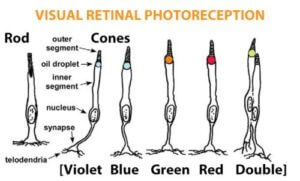
Knowing that cones are used to see color, humans have three pigment cones (trichromatic vision), poultry have four pigment cones (tetrachromatic vision) and swine have two (dichromatism vision).
Lighting for humans is typically categorized on a white scale, but white light, particularly sunlight, is made of all the colors. Think of a glass prism and how it separates white light into all colors. If the individual colors are mixed differently, the color of the light we perceive changes.
As humans, we all have the same types of photoreceptors in our eyes and will perceive the same colors. The graph below shows the typical color sensitivity of a human. The smooth white line curve and large peak in the center shows that a typical healthy human eye responds to wavelengths between about 400nm to 750nm humans, and sees green and yellow colors better than they see blue and red. The higher the white line is on a color, the more sensitive the human eye is to that color. Looking more closely, you can see the height of the curve in both the red and blue spectrums are much lower than green, which indicates the human eye is not as sensitive to blue light or red light.
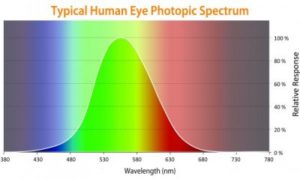
The main difference between the way humans see and the way a typical healthly chicken sees is the fourth cone. Instead of being sensitive to three color wavelengths, chickens are sensitive to four. In the graph below, you can see there are 4 (four) distinct color peaks. The highest sensitivity is green, which domestic fowls see similarly to humans. This is so both species can see well in the available light under green forest canopies, a part of our primary natural habitat. Domestic fowls also have a high sensitivity to blue and red, but you can see another one in the UV spectrum (far left bump on the curve).
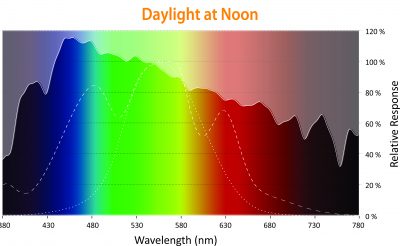
A bird processes light information differently, meaning they perceive light from ONCE®AgriShift® LED’s 25% brighter than we do. That is why foot candle measurements with a common light meter do not read the red and blue light spectrum. They measure what humans see, not what poultry see.
Because birds see UV, they experience a richer color landscape. The image below demonstrates how a human would see (on the left), the middle image only shows the UV spectrum and the far-right image shows how another bird would see, therefore color matters.
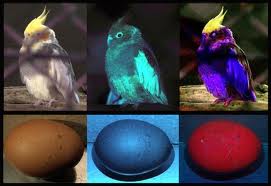
In the graph below we see that swine view the world more subdued than humans do. They only see 2 (two) distinct colors, blue and green – with the highest sensitivity being green light. The spectrum drops off significantly before the color red, showing that pigs cannot see that color efficiently.
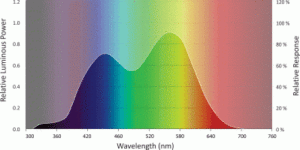
POULTRY-SPECIFIC